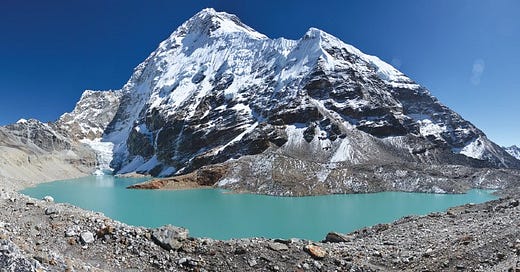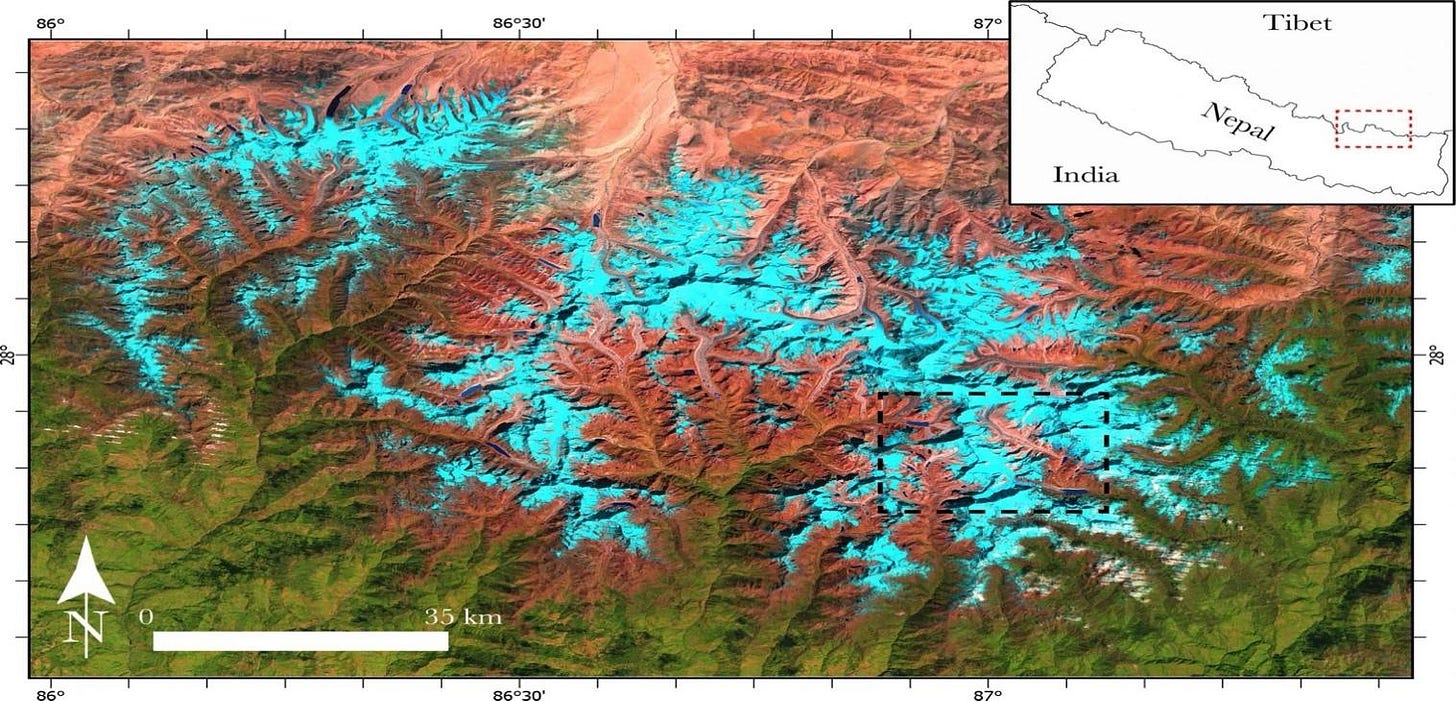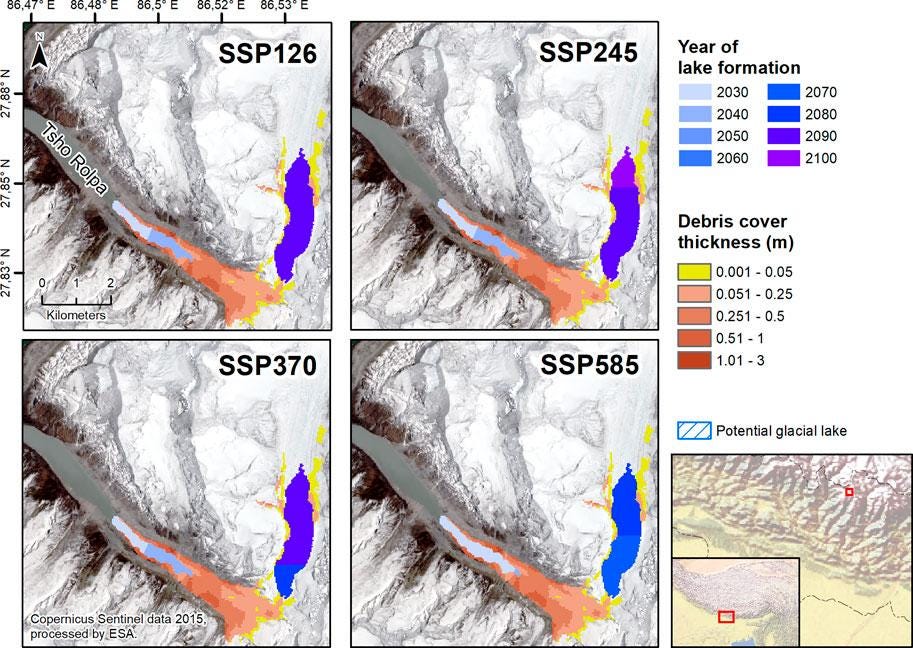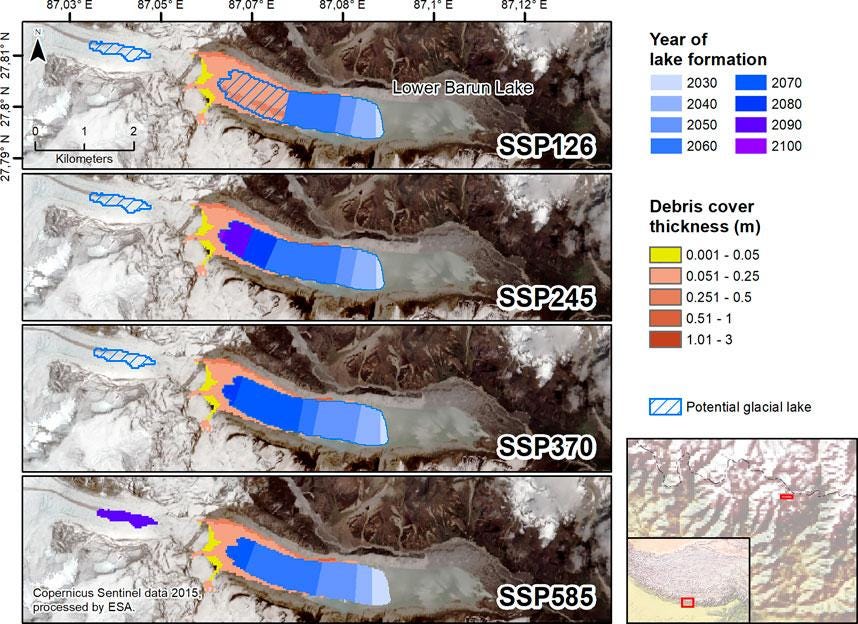Climate Change and the Growth of Glacial Lakes in the 21st Century
Around the World
Almost every news network is flooded with disastrous news about the many changes our climate is undergoing and the effects on our environment and affected humans across the globe because of this monumental shift. From wildfires torching entire cities to floods that inundate whole regions with water, the effects are actively felt by more and more people around the world. You may also be familiar with stories covering melting sea ice and its negative impact on the local wildlife, like polar bears suffering from the loss of their hunting grounds, or the potential for a global average of 3m in sea level rise if the Greenland ice sheet melts entirely. Though overwhelming at first, a deeper understanding of the natural processes taking place will support people and communities around the world in their fight to sustain the future for generations to come. To this effort, the effects of glacial melting, the formation of glacial lakes, and the risk they pose to communities downstream of potential Glacial Lake Overflow (GLOF) events should be explored in an ever-warming climate.
10% of the entire Earth is covered by glaciers, and they store 69% of the world’s freshwater. This accounts for a possibility of 70m of sea level rise as well as huge impacts on communities in the local watershed. Glaciers act like frozen rivers that slowly move downhill, eroding and molding the landscape over time. They form over the course of many years when layers of snow accumulate, like a cake, until the pressure from the uppermost layers compresses the lower layers into solid ice. You can generally see which ice is older by its color. The lower, blue ice is denser with fewer air pockets, while, generally, the lighter, whiter ice on top is filled with more air bubbles and is less dense.
Glaciers are particularly sensitive to the effects of climate change, and the rate of melting or forming of a glacier is called the mass balance ratio of the glacier. A positive net balance means that a glacier is growing (frequently observed during the Little Ice Age), whereas a negative mass balance indicates shrinkage. When glaciers melt, they have the potential to form glacial lakes, of which there are three main types: ice marginal, moraine-dammed, and supraglacial lakes. This categorization is used to study potential risk to nearby communities. Ice marginal lakes are dammed by the ice, preventing them from draining. Moraine-dammed lakes are dammed by chunks of ice with rocks and other debris, creating a sort of reservoir. Usually, these types have a small outflow, but not in every case. Finally, there are supraglacial lakes, which form on top of the glacier and might even connect to channels and rivers that flow within the glacier itself.
Recently, our understanding of glaciers and the cryosphere has begun to change drastically. Advances in big data cloud computing and access to large data sets of satellite imagery have enabled automation of the cryosphere. The cryosphere is the movement of ice around the globe, much in the way the hydrosphere describes the movement of water in geographical and geological terms. Up until now, the focus has been set on studying the regional dynamics of glacier melting and formation, but recent studies have expanded this search to encompass the entire globe. Since glacial lakes can store meltwater, these recent studies focus on how fast glaciers are melting and how much sea level rise will occur, and when. By gaining a better understanding of these aspects regarding glacial lake formations, people can make more sustainable decisions about how to adapt to the realities of a rapidly changing climate.
Now that the lake area and volume have been measured on a global scale, a benchmark can be set to study future glacial hazards and lake development in the coming century. In the period from 1990 to 2018, the size and number of glacial lakes have grown rapidly. 9414 glacial lakes were detected from 1990 – 1999. From 2015 -2018, this number has increased to 14394 glacial lakes, a 53% increase; a 51% increase in the total area of glacial lakes, and a global lake volume increase of 48%. This data primarily includes mountainous regions, since the lakes that form around the ice sheet in Antarctica or Greenland tend to drain directly into the ocean. Excluding these exceptions, glacial lakes capture .95% or .43mm of global glacial meltwater—certainly a small number. This number obscures the outsized impact on the local environment, however. In Nepal, for example, all the major lakes are glacial, highlighting the major impact of these glacial lakes on local ecosystems and the people who rely on them.
The HMA Region
Zeroing in on the specific impacts of glacial lake formation, a study, titled Projected 21st-Century Glacial Lake Evolution in High Mountain Asia, uses the global inventory of glaciers gathered in previous studies as a baseline for the exploration of the world’s third ice pole: the Himalayas. The world-famous mountains of the Himalaya, or as the study refers to it, the High Mountain Asia region, is the most heavily glaciated region outside of the Arctic and Antarctic regions. According to the Randolph Glacier Inventory, 95,536 glaciers cover an area of 97605km2 . According to future climate change models, the area will also see extreme ice loss in the coming century, up to 29% - 67% of the total ice mass having melted by 2100.
As glaciers continue to melt, there is a risk for the creation of new glacial lakes from the meltwater, or from rain and other precipitation, in a total of 25,000 over-deepening. A glacial overdeepening can form when a glacier retreats as it melts, and while many might fill with sediment and other debris, many can also act as reservoirs that will form glacial lakes. The benefit of having more lakes in high mountain areas can include more potential hydroelectric production, an increase in the availability of water, and drive up local tourism.
However, the risk posed by these often-unstable bodies of water can lead to Glacial Lake overflow events (GLOF events), which in the HMA region have caused the highest number of casualties anywhere in the world. These events are often caused by debris, such as rocks or ice, that causes the lake water to flow over the edges of its container, or the moraines (walls) of the lake having shifted, which then lets the water rush through. This torrent of water can carry rocks, ice, and massive amounts of water in a flood that rushes down the narrow mountain valleys towards any community downstream. This is a major risk as the adjacent areas are constantly growing due to many infrastructure projects that have allowed for more people to settle in high mountain areas. Therefore, this study aims to provide meaningful information for the timely adaptation of affected communities. This can be the placement of early warning systems or in the planning of where and how to build infrastructure, such as roads or dams, that are at risk of falling victim to a GLOF event.
As rising temperatures and consequently melting glaciers become more likely in this region, accurate information about the volume, area, location, and timing of glacial lake formation becomes essential knowledge for anyone downstream from these lakes. The basis for this study, therefore, is the shared socioeconomic pathway (SSP), which highlights four different scenarios of climate change by 2100. The lower end of the model, the SSP126, assumes that the Paris Climate agreement, which set a target of 2 °C in maximum global warming, is met in time to reduce most of the worst effects of climate change. The upper boundary of the SSP, conversely, assumes that a fossil-fuel fueled highly technological world persists, with little regard for carbon emissions or environmental destruction.
The HMA region is under particular risk of glaciers melting faster than the climate is currently warming. This is due, in part, to how glacial lakes are forming in the HMA. When a glacial lake forms in front of a glacier, which is also known as a proglacial lake, the speed at which the glacier melts accelerates due to a variety of factors. This can make it difficult for studies to accurately model how fast a glacier will melt based on the different SSP models. Therefore, more glacial lakes mean even faster melting of glaciers than what current models might predict.
The study also outlines potential uncertainties when it comes to how temperature will change within this region, as well as how precipitation patterns will either decrease or increase on average across the HMA. This points to the global relevance of the HMA region, as every glaciated region around the world will undergo similar changes, many of which are poorly understood and subject to a lot of uncertainty in the near and long term. This creates additional challenges to future adaptation strategies. Each pathway outlines how the climate will change as a direct result of our efforts today to curb carbon production. The specific SSP model we choose will directly influence the formation of glacial lakes.
Risk Assessment/GLOF Events
The RGI v6 inventory of glaciers is used to help predict potential GLOF hotspots. Specifically, the model predicts that 2,700 of the potential glacial lakes—some of which will grow, others will be newly formed—might become GLOF hotspots. This is due to a variety of reasons, such as the likelihood of ice or rocks to cause a mass-movement event, or an overflow of water which might break down the lake’s moraine. It also defines those lakes that will be particularly large and near communities. This is the case for lakes at lower elevations, which are potential GLOF hotspots.
Case Examples:
As of 2020, over 140,000 people might be affected by a GLOF event around the Tsho Rolpa River Basin in Nepal, and while some of the water was drained in 2000, the ever-increasing speed of ice loss poses a serious risk to the downstream communities. For example, the lake could grow by 50% or to over 2km before 2030 under the SSP585 model. This greatly increases the risk of mass-movement events due to the steep terrain surrounding the lake.
The planned construction of hydroelectric plants and other major infrastructure projects points to the necessity of site-specific surveys and studies. Without a proper understanding of the risk posed by rapidly growing lakes, billions might be wasted in the event of a flood. Here, the maximum lake extent of 1km2 might happen by as early as 2060 in the SSP585 scenario.
Where do we go from here?
The total increase in the volume and area of existing and future glacial lakes poses an opportunity for the local region to improve its hydroelectric capacity, tourism to the lakes, and improve water access. However, the serious risk to expensive infrastructure projects and the increasing danger to thousands of people who live in the area convey the need for a comprehensive risk mitigation strategy. By further classifying the risk of these glacial lakes, communities and policy makers can invest resources to mitigate the worst effects of GLOF events. For example, the most hazardous lakes are also those closest to civilization, and they also tend to be the largest by area and/or volume. By understanding which lakes will develop a high risk of a GLOF event, the time-consuming and expensive mitigation strategies can be invested in and implemented before it’s too late.
The importance of this comes into particular focus when considering that these rural communities have contributed minimally to the man-made acceleration of climate change, and yet they will be under far greater stress if the global community refuses to commit to climate change mitigation strategies. In the event of unexpected GLOF events, many lives will be lost, not to mention the devastating economic impact on many of these regions. It is therefore the global community’s responsibility to understand more clearly how glacial lakes will form in the 21st century and then implement consistent and timely strategies to reduce the worst effects of glacial lake overflow floods. A good inventory of potential glacial lakes is a great start, but there is still much work to do!









